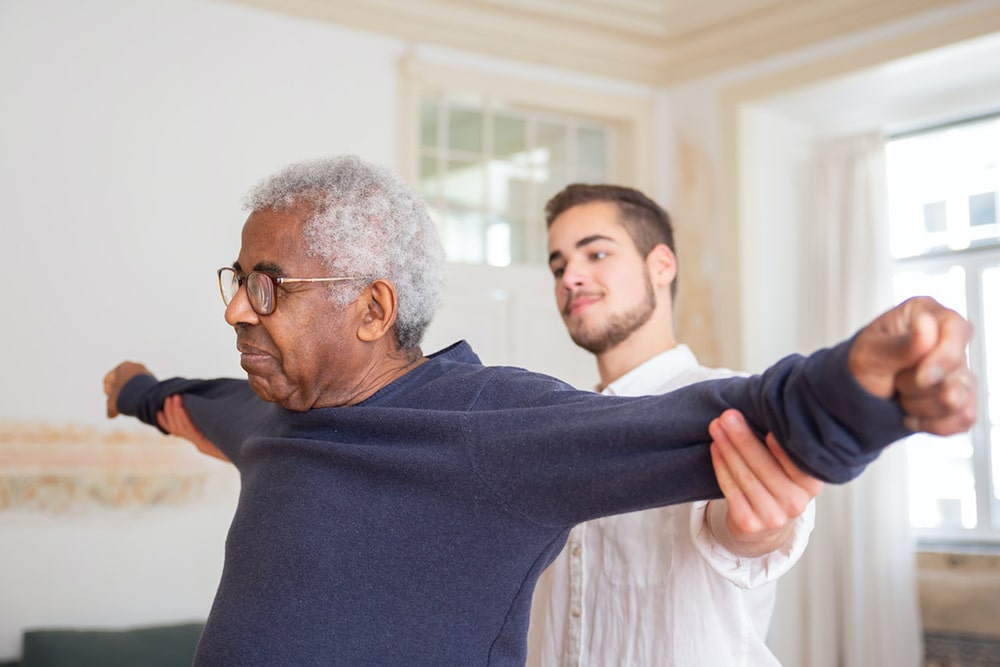A Guide To Preventing Falls in Nursing Homes

At least 1.6 million Americans reside in nursing homes, according to statistics published by the Agency for Healthcare Research and Quality (AHRQ). That same data suggests that nearly 50% of residents fall at least once per year in those long-term residential care facilities.
Many of those nursing home residents suffer serious injuries when they fall. Broken hips and blunt force head trauma, resulting in traumatic brain injuries (TBIs), are some of the most commonly reported concerns that stem from these incidents. These injuries are painful, often requiring surgical intervention and extensive rehabilitation. They can also leave behind long-term impacts and even prematurely claim residents’ lives.
The sad news is that, like most other personal injury incidents, these debilitating or life-altering falls are almost always completely preventable. Continue reading where our legal team at Prince Law Firm shares our guide to preventing falls in nursing homes in and around Marion, IL.
Why Falls Happen in Nursing Homes
Before we delve into steps that can be taken to prevent nursing home falls, we want to first highlight why they occur. Those reasons include the following:
Difficulties Balancing
Equilibrium problems often become more pronounced as we age, leading us to have difficulties balancing. Additionally, the less mobile we become, the weaker our muscles, which keep us upright, become. The combination of these factors leaves nursing home residents vulnerable to losing their footing and falling.
Balancing concerns, along with muscle weakness and a consequent reduction in mobility, are responsible for at least 24% of falls among nursing home residents. Another 27% of residents’ falls are attributable to environmental factors, such as poor lighting and dirty floors.
Chronic Medical Conditions
Malnourishment, which may be caused by a nursing home resident getting too little nutritious food or their bodies being unable to absorb the nutrients they need, can cause drops in energy and fatigue, leading to nursing home residents’ falls.
Many nursing home residents struggle with additional medical concerns or take medications that can cause sudden drops in blood pressure or blood sugar, which can easily cause them to fall if they attempt to move about without proper assistance.
Nursing Home Staff Neglect
Residents generally live in assisted living facilities because they cannot independently care for themselves. If there are too few staff members or they’re inattentive, residents may attempt to take matters into their own hands and try to make it to the bathroom alone, for example, tumbling and falling in the process.
This is far from an exhaustive list of reasons nursing home residents fall but merely serves as an example of the wide variety of reasons these incidents may happen.
What Can Be Done To Minimize Nursing Home Residents’ Falls
Many nursing home residents’ falls fit into a category of preventable accidents. In other words, they could have been avoided had it not been for the negligent actions of others. Some ways to prevent residents’ falls from occurring include:
Performing Fall Risk Assessments
One of the first steps in the right direction that nursing homes can take to minimize the chances of their residents suffering falls is to perform a fall risk assessment on residents as soon as they move in. The Centers for Disease Control and Prevention (CDC) has published a brochure outlining the steps in performing this test. The first one is for the nursing home to inquire whether the resident has fallen previously and, if so, to ask follow-up questions about that incident, such as:
- How often a fall has occurred
- Circumstances under which any falls have happened
- Whether injuries resulted from any falls
While residents 65 and over are considered to have a low fall risk, the CDC warns that nursing homes should have any residents who report falls perform additional physical exercises, which include the following, to determine where their fall risk stands:
- Timed up and go exercise
- A 30-second chair stand exercise
- A 4-stage balancing test
The CDC contends that nursing home residents with no gait, balancing, or strength problems that affect them have a low fall risk. However, those residents who appear to struggle with these must undergo additional evaluations to assess where their fall risk stands. The CDC argues that any resident deemed to have a moderate to severe fall risk needs to be closely monitored as their fall risk is exceptionally high compared to others.
Ensuring Nursing Home Residents Are Adequately Tended To
Staffing issues, such as improperly trained personnel and understaffing, resulting in overwork, are big concerns in Illinois nursing homes. These staffing matters often result in residents attempting to get up to do things independently when they cannot do so.
State authorities generally have staffing requirements that nursing homes must follow. These guidelines are in place to ensure all residents are adequately cared for, including feeling like they can rely on their caregivers for their needs instead of feeling compelled to take matters into their own hands, potentially putting them at risk of a fall. Thus, nursing home administrators can reduce the incident rates of residents’ falls by being more proactive with staffing.
Treating Chronic Health Conditions That Increase Fall Vulnerability
Long-term care facilities like nursing homes must keep close tabs on their residents’ health, ensuring they:
- Keep adequate tabs on residents’ vital signs
- Ensure residents receive prescribed medications as ordered by their physician
- Report any changes in their condition promptly
Residents who live in nursing homes where residents receive attentive and proactive care are more likely to experience more stability in their health situation, or, at the very least, if there are changes, their caregivers are more likely to notice it and get them the stabilizing help they need.
Keeping Environmental Hazards to a Minimum
It’s important to reduce the existence of as many potential fall hazards as possible, including environmental concerns that can potentially cause nursing home residents to tumble and fall, such as:
- Unstable furniture
- Any debris-strewn flooring, whether it’s covered in paper, boxes are in the way, or an extension cord runs across it
- Curled up and ripped carpets and floor mats
- Chipped or uneven tiles
- Any wet, soapy, oily, or waxy floors
Poor lighting can also leave residents vulnerable to falling. Residents can greatly minimize their risks of falling due to these environmental factors by ensuring their premises are clean and well-lit and by including handrails along walls for residents to grab onto if they feel unsteady on their feet.
Ensuring Nursing Home Residents Are Adequately Equipped With Assistive Devices
Many nursing home residents suffer from mobility issues, as referenced above. While these may be attributable to age-related factors, they can also be caused by chronic illnesses, muscle atrophy due to inactivity, the resident having a permanent disability, and other concerns.
Doctors will often order their patients to utilize assistive devices such as canes, crutches, wheelchairs, walkers, and more to stabilize them to make it easier for them to get around. It’s important that nursing home staff makes these assistive devices easily accessible to residents and encourages their use to reduce the chances of a fall happening.
Encouraging Residents To Remain Physically Active
As much as 24% of nursing home residents’ falls are attributable to problems with muscle weakness or gait. These mobility issues often arise out of residents being too sedentary. The existence of programming that gets residents up and moving instead of constantly sitting at a table doing arts and crafts or games is critical for maintaining their balance and flexibility, strengthening their muscles, and other functional medicine purposes.
Where To Seek Help if Your Nursing Home Resident Loved One Suffered a Fall
Nursing home residents’ falls aren’t always attributable to others’ negligence. They can be caused by residents becoming distracted, engaging in horseplay, and otherwise not being cautious enough.
Our nursing home abuse attorneys at Prince Law Firm regularly represent nursing home residents in and around Marion, IL who’ve suffered slips and falls that someone else’s actions caused. We’re more than willing to provide you with a free case evaluation to assess your rights and request compensation for the losses you’ve suffered. Our hope is that by helping you, it will minimize the chances of the nursing home or its staff putting anyone else in harm’s way in the future.
Reach out to our Marion personal injury legal team to schedule a free initial consultation to discuss the rights Illinois law affords nursing home residents who’ve had a fall.










